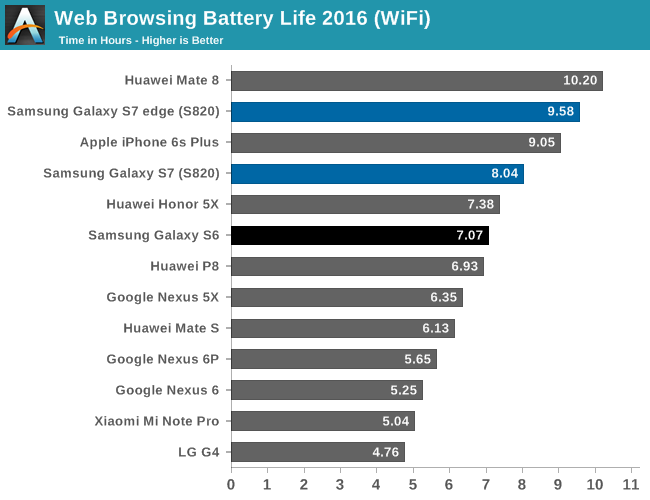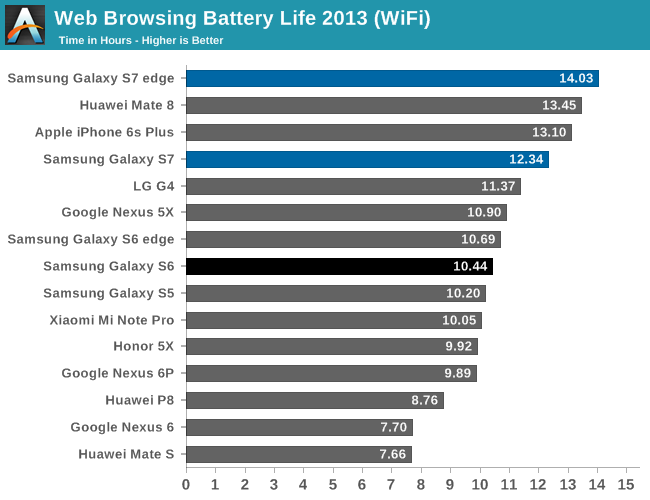The Samsung Galaxy S7 & S7 Edge Review, Part 1
by Joshua Ho on March 8, 2016 9:00 AM ESTBattery Life
Battery life remains one of the most important aspects of any mobile device. After all, you can’t really call something mobile if it has to spend most of its time connected to an AC adapter. As a result, battery life testing is one of the most critical aspects of our testing, and it’s something that we spend quite a lot of time discussing internally.
Before diving into our results, I want to start things off talking about testing methodologies. This year we're implementing an overhaul of our web browsing test for battery life, with the Galaxy S7 review being our first chance to deploy it. As far as our long-standing 2013 test goes, at a high level our 2013 test was relatively simple in the sense that it simply loaded a web page, then started a timer to wait a certain period of time before loading the next page. And after nearly 3 years it was time for it to evolve.
Internally, we’ve been discussing reasonable measures to push our web browsing test in new directions to both better represent real-world workloads in addition to ensuring that we’re testing more than just display power. For at least a few devices, it had already become quite evident that our old test was almost purely display-bound to such an extent that even video playback was more power intensive. Other issues that were raised both internally and externally included the fact that the test would not test aspects like CPU governor boosts upon touching the display, and that our test almost entirely ignored things like 2D drawing and display pipeline efficiency.
In recognition of these issues, we’ve spent the past few months working on a new test. In addition to new webpages that are exact copies of many popular websites today to better represent modern, real-world workloads, we’ve added a major scrolling component to this battery life test. The use of scrolling should add an extra element of GPU compositing, in addition to providing a CPU workload that is not purely race to sleep from a UI perspective. Unfortunately, while it would be quite interesting to also test the power impact of touch-based CPU boost, due to issues with reproducing such a test reliably we’ve elected to avoid doing such things.
However, we don’t take these changes lightly. While we’ve validated the workload for several devices, it’s important to emphasize that these results could change in the future as much of this data is preliminary. For the second part of the review I’ll be sure to revisit these results with an expanded dataset. Of course, other than the workload the device setup has been held constant across these tests by equalizing brightness to 200 nits and disabling all background sync to the best of my ability.

As we can see in the results, the Galaxy S7 and S7 edge both do impressively well. One of the more interesting comparison points here would be against the latest devices like the Huawei Mate 8, which has the Kirin 950.
Our previous test was relatively display-bound so differences in SoC efficiency were often difficult to discern and often masked entirely, but here we can see an enormous spread that is almost entirely due to SoC efficiency. The Huawei Mate 8, which under our previous test seemed to be only slightly above the iPhone 6s Plus, has gained a noticeable lead in this test as the Kirin 950’s CPU efficiency is ahead the competition at this time, although it’s important to keep in mind that CPU efficiency is not the only relevant metric for an SoC.
Interestingly enough, the Galaxy S7’s battery life is almost directly scaling with battery size relative to the Galaxy S6. As we’ll see in the display section, the Galaxy S7’s display is pretty much identical to the Galaxy Note5 and S6, so it looks like the efficiency gains from the Galaxy S6 to the S7 are small if you look at the Snapdragon 820 variant.
Of course, the big question that I’m sure a lot of people are thinking is how the Galaxy S7 and the Snapdragon 820 compare to the iPhone 6s and 6s Plus. Unfortunately, due to timing constraints we weren’t able to get data for the smaller iPhone 6s, but looking at the iPhone 6s Plus relative to the Galaxy S7 edge it’s pretty obvious that there is a power efficiency gap between the two in this test. Despite the enormous difference in battery size - the Galaxy S7 edge has a battery that is 33% larger than the iPhone 6s Plus - the difference in battery life between the iPhone and Galaxy in this test is small, on the order of half an hour or 5-6%. This is balanced against a higher resolution (but AMOLED) display, which means we're looking at SoC efficiency compounded with a difference in display power.

In the interest of providing another data point and some validation of our testing results, I ran both devices through our old web browsing test to see what the results would be for something that should be display-bound. Here, it’s obvious that the Galaxy S7 edge holds a significant lead over the iPhone 6s Plus, although the use of a higher resolution display and an AMOLED display in a high-APL test means that the GS7e is using more power in this test as well. However, when you take these results with our new web browsing test, it becomes evident that a difference in power efficiency is growing as the load on the SoC grows. Similarly, despite the Galaxy S7 being neck and neck with the Huawei Mate 8 in our older test, it loses the lead in our new web browsing test.
Of course, I have caution that all of the data that we’re gathering for the web browsing test is still subject to change, but given the interesting data that it provides it’s important for us to include these results, as we’re reasonably confident that these results are accurate.
Overall though, it’s clear that the Galaxy S7 and S7 edge will have solid battery life, even if device efficiency isn’t quite on par with the very best that we’ve seen so far. An improvement of 15% is going to be noticeable if you upgrade from the Galaxy S6, and anyone upgrading from a phone with an SoC older than the Snapdragon 800/801 generation will see huge improvements here.











202 Comments
View All Comments
Michael Wilding - Tuesday, March 8, 2016 - link
Great write up Josh. I'm looking forward to seeing the camera performance, and the Adreno 530 is a beast! Let's hope performance can be sustained without significant throttling.warreo - Tuesday, March 8, 2016 - link
Yes, somewhat disappointed that overheating wasn't addressed in Part 1 given Andrei's skewering of Samsung's use of a heatpipe and his comments that the S7 got pretty hot under load. Hope it gets addressed in detail for Part 2!Ethos Evoss - Wednesday, March 9, 2016 - link
That is awesome that in EU will have Exynos 8890 .. crappy SD820 battery drainer..Azurael - Thursday, March 10, 2016 - link
I seem to recall that real world battery life has traditionally been worse on Samsung SoCs than Qualcomm's mainly due to the modems using a lot more power - hopefully they've resolved that this generation... Personally, I'm disappointed that we get the Exynos version in Europe because it means there will probably never be a fully working AOSP port.leexgx - Monday, March 14, 2016 - link
be nice to add CUBOT H1 results in there as well (i had the phone for like a month or 2 now and 2 days of active use is lovely without having to use an external battery that norm would still only last me a day on my last phone)my use i am typically getting 8 hours screen on time (i use GPS a lot so i never expect to get the 12 hours screen on time, or probably mythical 15-18 hours if anandtech benched it for power)
leexgx - Monday, March 14, 2016 - link
anandtech review http://www.anandtech.com/show/9868/cubot-h1-smartp...not sure if the phone is fully suitable for USA due to 3G and (real) 4G Bands been used on the phone
Ethos Evoss - Wednesday, March 9, 2016 - link
Huawei Mate 8 rocks .. still !jjj - Friday, March 11, 2016 - link
A throttling result for the Exynos variant of the Edge with a 42% drop http://www.techspot.com/articles-info/1147/images/...MaxIT - Monday, March 14, 2016 - link
... as usual. Samsung and Qualcomm just can't balance their system. They just look for a benchmark number to impress people and try to be competitive with Apple. But that's just a smoke curtain...jjj - Wednesday, March 9, 2016 - link
There is finally a GFXBench long term perf result for the MI5 https://gfxbench.com/device.jsp?benchmark=gfx40&am...There are some complications though, the device is just 1080p, the 60FPS limit,no heatpipe. While keeping all that in mind, we do see a 37% drop and this test is not the worst case scenario. Hopefully Andrei will have a better test based on OpenGL ES 3.x or test it with some actual games since T-Rex is becoming outdated.